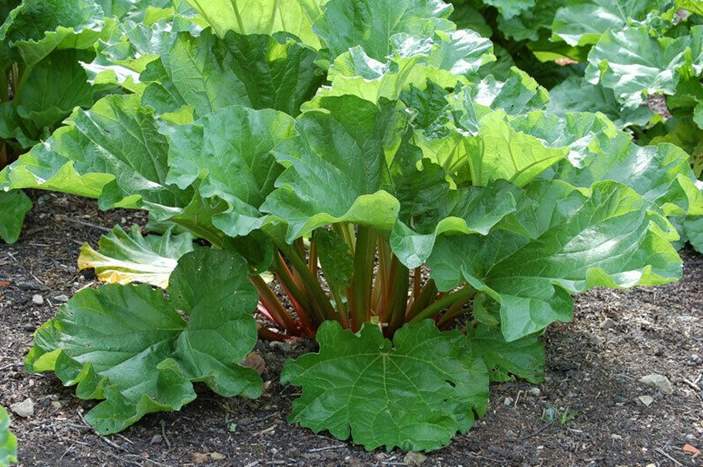Rhubarb is a vegetable in the genus Rheum and family Polygonaceae (the smartweed, buckwheat, or knotweed family). People value it for its edible stalks (petioles), which you can stew in sugar or use in desserts, pies, jellies, jams, savory dishes, pickle or dry, and infuse to juice.
Rhubarb has celery size petioles may be red, speckled light pink, or light green depending on the variety. It has inedible (since they are high in oxalic acid as well as anthrone glycosides) large, triangular-shaped leaves, and the thick rhizomes are known as rhubarb.

Can rabbits eat rhubarb leaves or stalks?
No. Rabbits shouldn’t eat rhubarb leaves, stalk, flowers (tops or greens), or rhizomes. Any part of this plant is a big no. It is an irritant and potentially toxic, and most species, mostly Chinese (Rheum officinale), Turkey (Rheum palmatum), Garden (Rheum rhabarbarum), and False rhubarb (Rheum rhaponticum) since they are high in oxalic acid.
Kindly note that wild rhubarb (Actium minus, louse-bur, common burdock, button-bur, cuckoo-button, little burdock, or lesser burdock), is an unrelated plant whose foliage is also potentially toxic.
How much oxalic acid does it have? It has oxalic acid, which ranges from 300-1500 mg per 100g (1). Other sources put the amount much higher (570-1900 mg per 100g).
Rhubarb leaves have 590-720mg of oxalic acid per 100g, the petioles (leaf stalks) also have oxalic acid. However, its amount is much lower when compared to leaves. The stems have about 390-540mg per 100g.
Other parts of the plant also have oxalic acid, and the roots have anthraquinones, thought to have medicinal value in herbal medicine. However, prolonged use has been linked to acute kidney failure, notes the Journal of Occupational Medicine and Toxicology.
Oxalic acid is a nephrotoxin whose long-term use may cause kidney stones. Oxalates may form calcium oxalate stones that will be deposited in the urinary bladder and kidney, where they will cause blockage and a lot of irritation.
Also, calcium oxalate is an oral and eye irritant, a reason why rhubarb causes oral irritation characterized by various symptoms we are going to mention.
Signs of toxicity?
While in the wild, rabbits tend to avoid this vegetable or may nibble just a little amount that is unlikely to cause any issues. However, if your furry friend ingests a lot of this vegetable, especially leaves, some of the symptoms you may notice include:
- Mouth or oral irritation characterized by pawing and drooling
- Reduced appetite
- Diarrhea
- Lethargy
- Stomach tenderness
- Severe dehydration
- Death may occur, but it is infrequent.
Please talk to your rabbit-savvy veterinarian if you notice any of these symptoms or suspect that your rabbit has consumed a lot of rhubarb or any other plant high in oxalic acid.
What other plants and foods to avoid?
Rhubarb joins other toxic plants and plants that include but not limited to, the following:
- Chocolate
- Allium vegetables (onions, garlic, chives, leeks, spring onions, and Chinese onions)
- Iceberg lettuce
Potato, eggplant, and tomato tops - Hemlock
- Foxglove
- Elder
- Fool’s parsley
- Bindweed
- Belladonna
- Delphinium
- Ragwort
- Ivy
More about rhubarb
There are both the hothouse rhubarb (grown in heated greenhouses) that are brighter red, tender, and more sweet tasting than those that grow outside.
Various cultivars and varieties have different colors, taste, sweetness, or bitterness. Oxalic acid levels may vary from one cultivar to another.
Some of the common cultivars include Grandad’s Favourite and Reed’s Early Superb, McDonald’s Canadian Red, Colorado Red, and Holstein Bloodred. Others are Stein’s Champagne, Timperley Early, Hawke’s Champagne, German Wine, Victoria, Timperley Early, Early Albert, and Gaskin’s Perpetual, the Sutton, among others.
Finally, nutritionally, this vegetable has vitamin C and K. It also has small amounts of manganese, potassium, calcium, and other nutrients.
Conclusion
If you have rhubarb or any other plant toxic to rabbits, consider fencing around your garden to limit access or use some of the effective rabbit repellents to keep bunnies off your garden. They may accidentally nibble something toxic.
